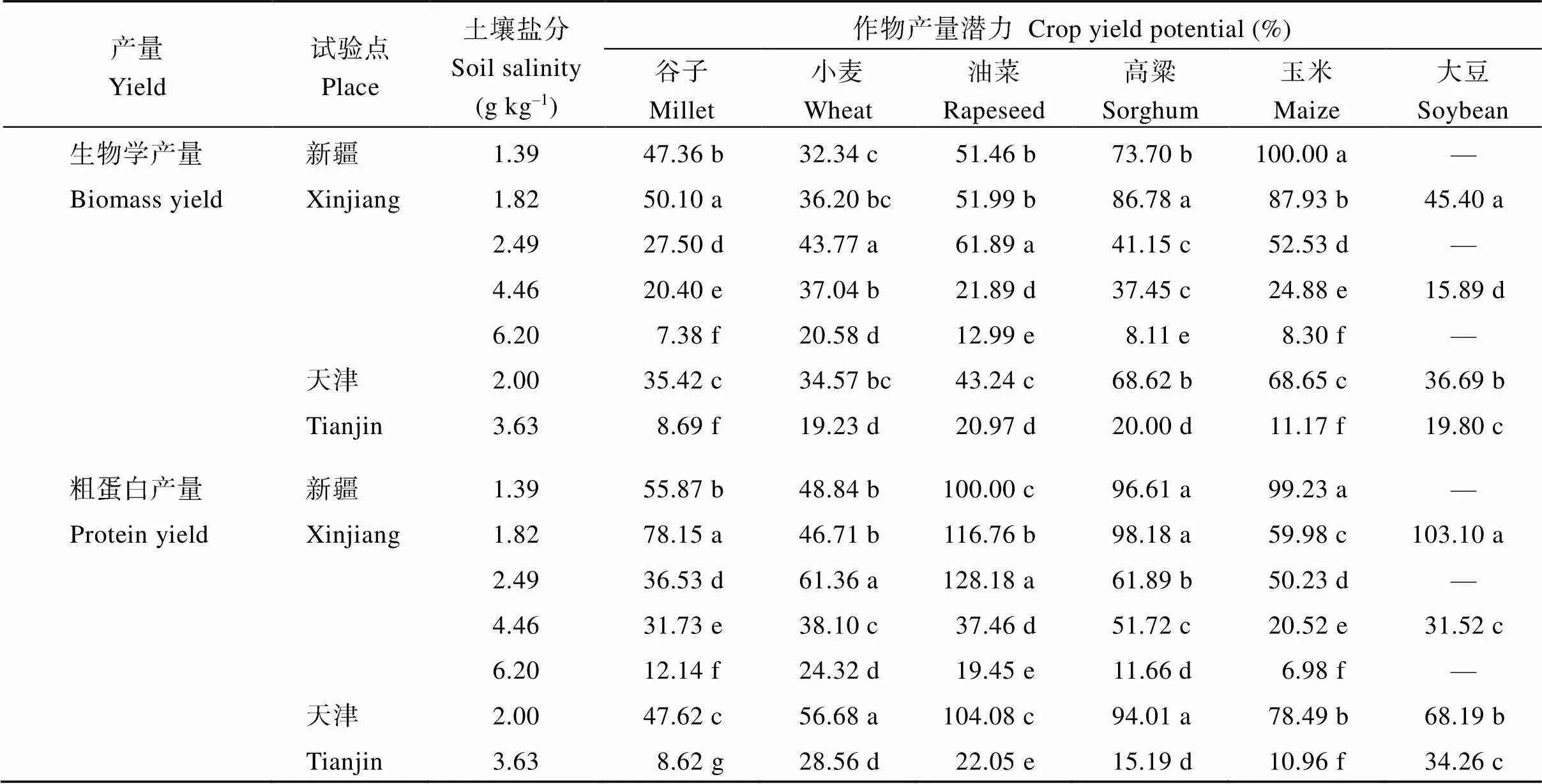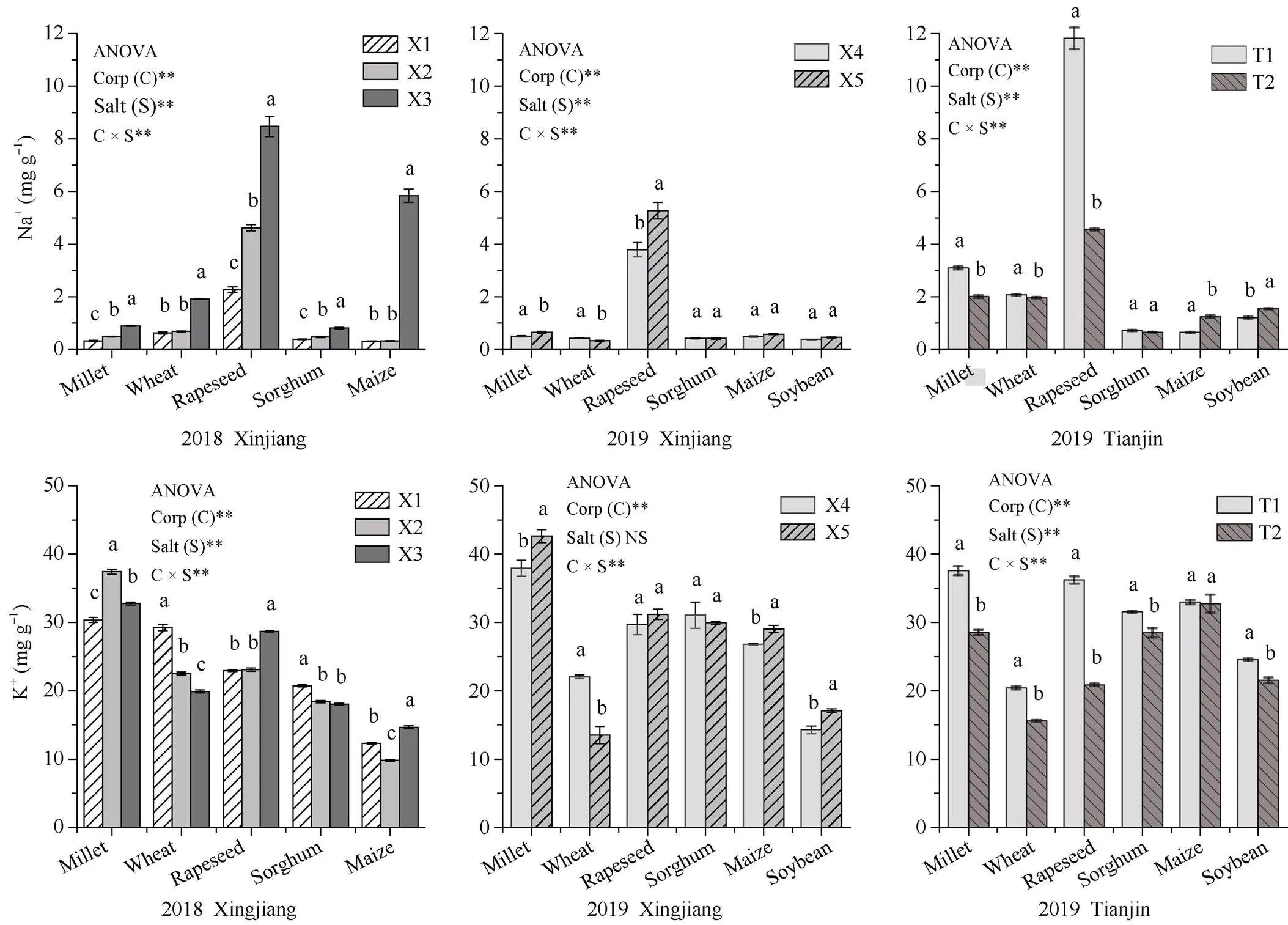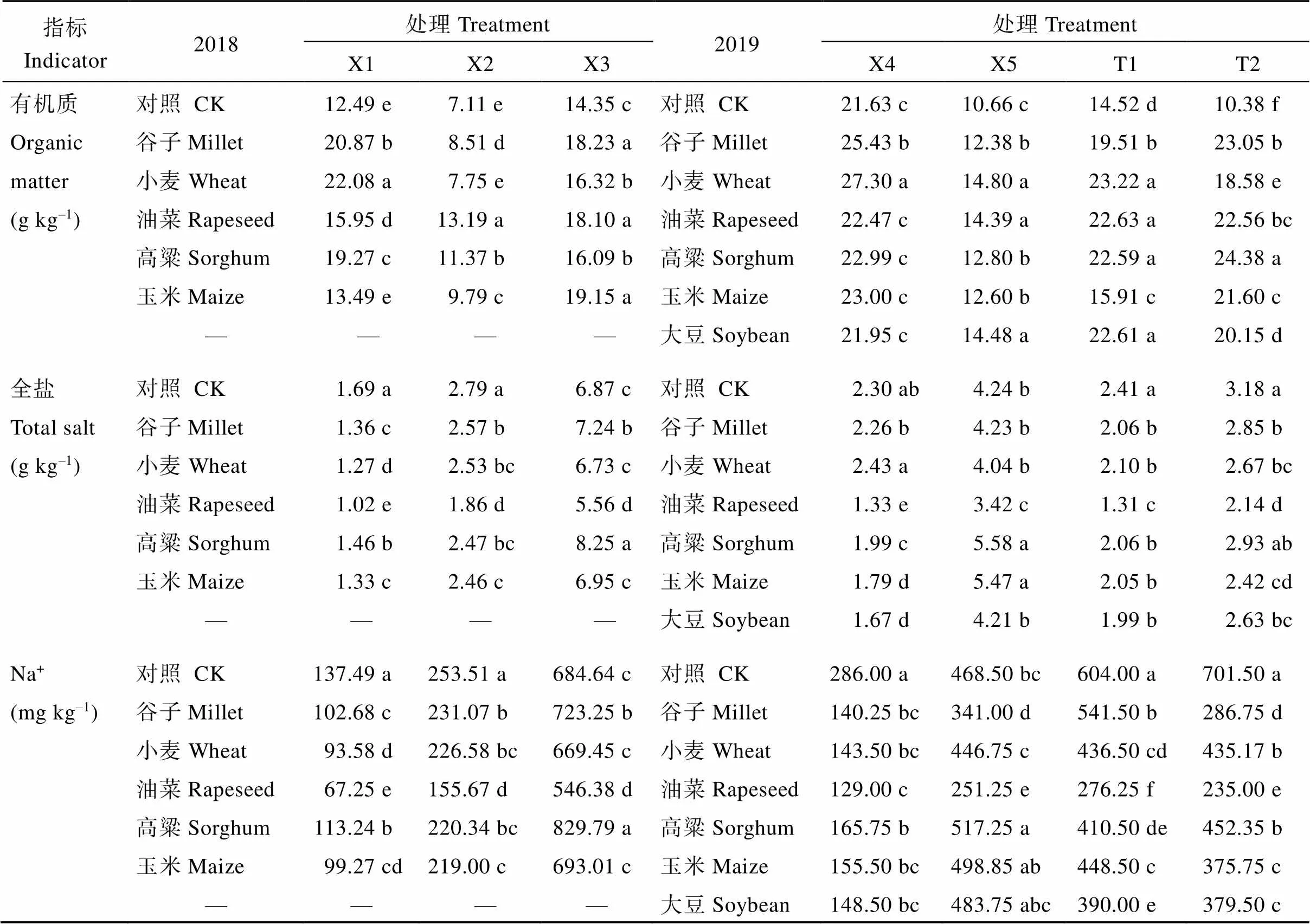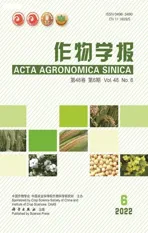大田作物在不同盐碱地的饲料价值评价
2022-04-08王旺年葛均筑杨海昌阴法庭黄太利周广生傅廷栋
王旺年 葛均筑 杨海昌 阴法庭 黄太利 蒯 婕 王 晶 汪 波,* 周广生 傅廷栋
大田作物在不同盐碱地的饲料价值评价
王旺年1,4葛均筑2杨海昌3阴法庭3黄太利5蒯 婕1王 晶1汪 波1,*周广生1傅廷栋1
1华中农业大学植物科学技术学院, 湖北武汉 430070;2天津农学院农学与资源环境学院, 天津 300384;3石河子大学农学院, 新疆石河子 832003;4玉林市农业科学院/广西农业科学院玉林分院, 广西玉林 537000;5大冶市畜牧兽医局, 湖北大冶 435100
我国盐碱地分布广、面积大。在盐碱地选种有饲料价值的作物, 实现种养循环, 对推动我国草食畜牧业的发展及盐碱地改良具有重要意义。本研究分别在天津滨海盐碱地(NaCl型)和新疆西北内陆盐碱地(Na2SO4-NaHCO3型)选取盐碱度差异大的地块, 种植具有饲料价值的玉米、高粱、小麦、谷子、大豆、油菜等大田作物, 测定生物学产量、植株粗蛋白含量、钠离子、钾离子含量等指标。结果表明, 在NaCl型和Na2SO4-NaHCO3型盐碱地, 当其含盐量分别低于1.82 g kg–1和2.00 g kg–1时, 各作物生物学及蛋白质产量均与常规耕地接近, 可作为饲料生产基地加以利用; 当Na2SO4-NaHCO3型盐碱地含盐量达2.49 g kg–1时, 油菜生物学及蛋白质产量均显著高于其他作物, 因此可种植油菜作饲料开发利用; 当NaCl型和Na2SO4-NaHCO3型盐碱地含盐量分别达3.63 g kg–1和4.42 g kg–1时, 各作物生物学及蛋白质产量均低于常规耕地的51.72%, 利用价值低, 建议改良后利用。在两试验点的不同地块, 油菜对土壤Na+的富集量均显著高于其他作物(<0.05), 同时也显著降低了土壤全盐量和Na+含量。本试验中, 在含盐量分别为1.82、2.00、2.49 g kg–1的地块中, 油菜富集Na+效果最为明显, 油菜对土壤Na+的富集量分别为39.45、102.24、57.19 kg hm–2, 分别占0~20 cm耕层土壤Na+的13.02%、15.99%、8.94%, 盐碱地改良效果显著。上述结果为利用我国盐碱地进行草食饲料原料生产, 促进草食畜牧业发展及盐碱地改良提供了参考。
饲料作物; 生物学产量; 粗蛋白产量; 土壤盐含量; Na+含量
随着我国畜牧业发展, 饲料需求持续增加[1], 供给矛盾加剧。2017年我国饲料缺口5850万吨[2], 其中草食饲料缺乏是限制我国草食畜牧业发展的重要因素[3]。粮食型饲料为我国主要饲料原料, “人畜争粮”局面引发了全社会关注的粮食安全问题[4]。因此, 我国在“十三五”期间大力推进“粮改饲”与种养结合模式[5-6]。示范推广具有饲料价值的农作物, 可在保障我国粮食安全、缓解饲料矛盾的同时, 提高农业生产效益[7]。
我国盐碱地面积约3666万公顷[8], 且大部分盐碱地未得到开发利用[9]。开展盐碱地治理研究, 对改善盐碱地质量和提高土地生产力具有重要作用[10]。国内相关研究主要有土壤脱盐(如植物积累土壤盐分离子, 根际固定、过滤离子等)[11-12]、改善土壤理化性状(如提高肥力、保水性, 改善通透性等)[13-15]和增加土壤酶及微生物活性(如提升β-葡萄糖苷酶、碱性磷酸酶活性, 增加真菌丰度等)[16-18]3个方向。种植耐盐碱植物是盐碱地治理的重要措施[19-20]。目前利用的耐盐碱植物主要有盐生植物(如藜木、鼠尾草等)[21-23]和耐盐性较强的经济作物(如燕麦、棉花等)[24-25]。
Na+是盐碱土壤中的主要毒性离子[26]。相对于盐生植物, 经济作物地上部Na+含量低, 通过作物富集并降低土壤Na+的作用不明显[27], 且需结合覆膜滴灌[28]、淋洗盐分等[29]农艺和水利措施[19]。本试验拟结合饲料生产与盐碱地修复, 在不同类型及盐碱程度的土壤中种植具有饲料价值的玉米、高粱、小麦、谷子、大豆、油菜等大田作物, 比较不同作物的饲料产量、品质及盐碱地治理效果, 为我国盐碱地治理及利用提供技术支撑。
1 材料与方法
1.1 试验地概况
试验点选用新疆维吾尔自治区石河子市石河子大学试验站(44.3311ºN, 86.0016ºE)和天津市静海区天津农学院试验站(38.8593ºN, 117.2152ºE), 盐碱地类型分别为Na2SO4-NaHCO3型和NaCl型(表1)。试验分别于春小麦(新疆试验点)、冬小麦(天津试验点)收获期后开展, 其中2018年新疆试点3个地块含盐量分别为1.39 (X1)、2.49 (X2)、6.20 g kg–1(X3), 试验期间降雨量为45.4 mm, 大于10℃的有效积温为1605.3℃; 2019年, 新疆试点2个地块含盐量分别为1.82 g kg–1(X4)和4.46 g kg–1(X5), 试验期间降雨量为24.5 mm, 大于10 ℃的有效积温为1643.9℃; 天津试点2个地块含盐量分别为2.00 g kg–1(T1)和3.63 g kg–1(T2), 试验期间降雨量为113.0 mm, 大于10℃的有效积温为1784.5℃。各试验地初始土壤关键指标见表1和表2。
Na+、Ca2+、HCO3–、SO42–为新疆试点含盐量大于等于2.49 g kg–1地块的主要离子, 分别占全盐含量的8.84%~9.84%、14.46%~17.71%、10.84%~13.71%和12.78%~14.52%, 为Na2SO4-NaHCO3型; Na+、Ca2+、Cl–、SO42–为天津试点含盐量为3.63 g kg–1地块的主要离子, 分别占全盐含量的16.02%、14.36%、46.69%和14.36%, 为NaCl型[30]。

表1 供试土壤主要离子的含量
X1、X2、X3为2018年新疆试验点试验地块, X4、X5为2019年新疆试验点试验地块, T1、T2为2019年天津试验点试验地块。
X1, X2, and X3 are the plots of Xinjiang in 2018, X4 and X5 are the plots of Xinjiang in 2019, T1 and T2 are the plots of Tianjin in 2019.

表2 供试土壤的主要指标参数
X1、X2、X3为2018年新疆试验点试验地块, X4、X5为2019年新疆试验点试验地块, T1、T2为2019年天津试验点试验地块。
X1, X2, and X3 are the plots of Xinjiang in 2018, X4 and X5 are the plots of Xinjiang in 2019, T1 and T2 are the plots of Tianjin in 2019.
1.2 试验材料
2018年新疆试点供试材料为: 甘蓝型油菜‘华油杂62’、常规玉米‘新玉70’、小麦‘新冬33’、谷子‘神谷7号’、高粱‘团结6号’。2019年天津与新疆试点供试材料均为: 甘蓝型油菜‘华油杂62’、青贮玉米‘大京九26’、小麦‘津强7号’、大豆‘中黄13’、谷子‘衡谷13号’、甜高粱‘甜杂2号’。
1.3 试验设计
2018年在新疆试点选用含盐量较轻的常规耕地(X1)为对照, 以含盐量较高的2个地块(X2和X3)为处理; 2019年在新疆、天津2个试点, 均选用含盐量较轻的耕地为对照, 分别记为X4和T1, 以含盐量较高的地块为处理, 分别记为X5和T2。各地块均种植玉米、高粱、小麦、谷子、大豆、油菜等作物, 密度分别为8×104、1.6×105、9×106、6×105、4.8×105和3×105株 hm–2。随机区组排列, 3次重复; 小区面积设为12 m2(6 m×2 m)。播种前施磷酸二铵(N∶P2O5=18%∶46%) 375 kg hm–2、尿素(46.4% N) 50 kg hm–2、硫酸钾40 kg hm–2(K2O≥50%, S≥16%)为基肥。2018年, 新疆试点播种期为7月28日; 2019年, 新疆、天津试点播种期分别为7月30日和4月22日。播种后滴灌确保出苗。
1.4 测定项目及方法
1.4.1 样品采集 在油菜初花期(播种80 d左右)采集作物样品、在播种前3 d和油菜初花期采集土壤样品, 均为3个重复。各小区作物留茬2 cm收割作物地上部, 收获面积均为4.8 m2, 称作物鲜重后, 随机留取2 kg左右鲜样, 在105℃条件下杀青1 h, 75℃烘干至恒重作为采集的作物样品, 用于计算各小区干物质重和测定作物地上部分粗蛋白、Na+、K+含量。各小区土壤样品用五点取样法取样, 使用取土钻(5 cm)在各作物行间采集5份0~20 cm土层的土样, 将5份土样混合为1个样品, 将土壤样品避光自然风干, 剔除杂物后过20目和100目筛, 用于测定土壤全氮、有机质、碱解氮、速效磷、速效钾、Na+和K+含量。
1.4.2 测定方法 烘干粉碎后的作物样品过40目筛, 用H2SO4-H2O2法消煮, 稀释过滤后采用火焰分光光度计法测定作物地上部分Na+、K+含量; 采用凯氏定氮法测定作物地上部分全氮含量[31]。
用凯氏定氮法测定土壤全氮; 重铬酸钾-硫酸氧化(外加热法)测定土壤有机质; 碱解扩散法测定土壤碱解氮; 0.5 mol L–1碳酸氢钠溶液浸提-钼锑抗比色法测定土壤速效磷; 1.0 mol L-1乙酸铵浸提-火焰分光光度计法测定土壤速效钾; 蒸发法测定(土∶水=1∶5)土壤全盐、火焰分光光度计法测定(土∶水=1∶5)土壤Na+、K+ [31]。
1.4.3 生物学产量 根据作物小区测产鲜重、所取样品鲜重及烘干后样品干重, 计算小区植株干物质率和作物生物学产量。

1.4.4 粗蛋白产量、作物Na+吸收量 根据作物小区测产鲜重、样品植株干物质率、植株全氮含量、植株Na+含量, 分别计算作物粗蛋白产量和作物Na+吸收量。

土壤耕层体取样范围为0~20 cm, 土壤耕层体积为2000 m3hm–2
1.4.5 作物生物学产量潜力、粗蛋白产量潜力
根据新疆地区常规耕地(X1)的作物生物学产量、粗蛋白产量和其他地块作物生物学产量、粗蛋白产量, 分别计算不同作物在不同含盐量地块中的作物生物学产量潜力和作物粗蛋白产量潜力。

1.5 数据分析
采用SPSS19.0软件进行数据统计分析。采用最小显著差法(Least significant difference, LSD)进行差异显著性分析。
2 结果与分析
2.1 盐碱胁迫对作物粗蛋白含量的影响
在不同含盐量的地块中, 作物的粗蛋白含量存在差异(图1)。在天津试验点中, 高盐处理下作物粗蛋白含量显著下降, 而在新疆试验点, 随着土壤含盐量增加, 作物粗蛋白含量变化有所不同。在2018年新疆试验点中, 随着土壤含盐量增加, 油菜、高粱的粗蛋白含量呈先增加后降低的趋势, 小麦、玉米的粗蛋白含量降低, 谷子粗蛋白含量增加。在2019年新疆试验点中, 高盐处理下谷子、小麦、油菜、大豆的粗蛋白含量降低, 高粱、玉米的粗蛋白含量增加。各作物中, 油菜在土壤含盐量低于2.49 g kg–1的各地块中粗蛋白含量较高, 为15.03%~18.66%, 玉米的粗蛋白含量最低, 为5.28%~7.70%; 在2018年新疆试验点土壤含盐量为6.20 g kg–1的地块中, 谷子的粗蛋白含量为12.75%, 显著高于其他作物; 大豆在2019年新疆、天津试验点土壤含盐量分别为4.46 g kg–1和3.63g kg–1的地块中的粗蛋白含量为15.38%和13.41%, 显著高于其他作物。
2.2 盐碱胁迫对作物生物学产量和粗蛋白产量的影响
在不同含盐量的地块中, 饲料作物生物学产量和粗蛋白产量存在差异(图2)。随着土壤含盐量增加, 谷子、小麦、高粱、玉米的生物学产量、粗蛋白产量下降, 小麦、油菜在2018年新疆试验点中在土壤含盐量为2.49 g kg–1的地块中生物学产量、粗蛋白产量最高。
高粱、玉米在土壤含盐量等于低于2.00 g kg–1的各地块中生物学产量较高, 为13.72~19.99 t hm–2, 显著高于其他作物; 油菜在土壤含盐量等于低于2.49 g kg–1的各地块中粗蛋白产量最高, 为1.55~ 1.99 t hm–2, 显著高于其他作物。在2018年新疆试验点中, 油菜在土壤含盐量为2.49 g kg–1的地块中生物学产量为12.37 t hm–2, 显著高于其他作物; 小麦在土壤含盐量为6.20 g kg–1的地块中的生物学产量和粗蛋白产量显著高于其他作物, 分别为4.11 t hm–2和0.43 t hm–2。在2019年新疆试验点土壤含盐量为4.46 g kg–1的地块中, 小麦、高粱的生物学产量分别为7.40 t hm–2和7.49 t hm–2, 显著高于其他作物; 高粱的粗蛋白产量为0.80 t hm–2, 显著高于其他作物。在2019年天津试验点土壤含盐量为3.63 g kg–1的地块中, 油菜的生物学产量最高, 为4.19 t hm–2; 大豆的粗蛋白产量为0.53 t hm–2, 显著高于其他作物。
2.3 盐碱地作物产量潜力
在2018年新疆试验点常规耕地(X1)中, 在油菜初花期阶段玉米生物量最大, 油菜粗蛋白产量最高, 分别以常规地块玉米生物量及油菜粗蛋白产量为对照, 研究不同作物在各含盐量地块中的最高生产潜力。
在新疆试验点中, 谷子、小麦、油菜、高粱的生物学产量潜力、粗蛋白产量潜力随着含盐量增加呈现先增加后减少的趋势(表3)。谷子、高粱的生物学产量潜力和粗蛋白产量潜力在土壤含盐量1.82 g kg–1的地块中高于常规耕地, 在土壤含盐量为2.49 g kg–1地块中显著低于常规耕地; 油菜的生物学产量潜力和粗蛋白产量潜力在土壤含盐量为2.49 g kg–1地块中显著高于常规耕地, 在土壤含盐量为4.46 g kg–1地块中显著低 于常规耕地; 小麦的生物学产量潜力在土壤含盐量为4.46 g kg–1的地块显著高于常规耕地, 在土壤含盐量为6.20 g kg–1地块显著低于常规耕地; 玉米的生物学产量潜力、粗蛋白产量潜力随着土壤含盐量的增加而下降, 当土壤含盐量为1.82 g kg–1时, 玉米的生物学产量潜力和粗蛋白产量潜力显著低于常规耕地。

图1 不同含盐量地块作物粗蛋白含量差异
柱上不同小写字母表示同一试验点同一含盐量地块不同作物粗蛋白含量在0.05水平差异显著, **表示在0.01水平差异显著。新疆试验点X1、X2、X3、X4、X5地块的土壤含盐量分别为1.39、2.49、6.20、1.82和4.46 g kg–1, 天津试验点T1、T2地块的土壤含盐量分别为2.00 g kg–1和3.63 g kg–1。
Different lowercase letters above the bars indicate significant differences among crude protein content of crops in same salt content plots at the 0.05 probability level in same test point, and ** indicate significant differences at the 0.01 probability level. The soil salt content of the X1, X2, X3, X4, and X5 plots in Xinjiang was 1.39, 2.49, 6.20, 1.82, and 4.46 g kg–1, respectively. The soil salt content of the T1 and T2 plots in Tianjin was 2.00 g kg–1and 3.63 g kg–1, respectively.

(图2)
柱上不同小写字母表示同一试验点同一含盐量地块不同作物产量潜力在0.05水平差异显著, **表示在0.01水平差异显著。新疆试验点X1、X2、X3、X4、X5地块的土壤含盐量分别为1.39、2.49、6.20、1.82和4.46 g kg–1, 天津试验点T1、T2地块的土壤含盐量分别为2.00 g kg–1和3.63 g kg–1。
Different lowercase letters above the bars indicate significant differences among different crops yield potential in same salt content plots at the 0.05 probability level in same test point, and ** indicates significant differences at the 0.01 probability level. The soil salt content of the X1, X2, X3, X4, and X5 plots in Xinjiang was 1.39, 2.49, 6.20, 1.82, and 4.46 g kg–1, respectively. The soil salt content of the T1 and T2 plots in Tianjin was 2.00 g kg–1and 3.63 g kg–1, respectively.

表3 作物生物学产量和粗蛋白产量生产潜力
“—”表示无数据。同列不同小写字母表示同一试验点不同含盐量地块作物产量潜力在0.05水平上的差异显著。
“—” means no data. Different lowercase letters in the same column indicate significant differences among crops yield potential in different salt content plots at the 0.05 probability level in same plot.
在天津试验点中, 当土壤含盐量为2.00 g kg–1时, 小麦、高粱的生物学产量潜力与新疆试验点的常规地块无显著差异, 可认为作物在天津试验点土壤含盐量为2.00 g kg–1地块中具备正常的生产力。在新疆、天津试验点, 当土壤含盐量分别高于4.46 g kg–1和3.63 g kg–1, 作物生物学产量潜力分别低于37.45%和20.97%, 粗蛋白产量潜力分别低于51.72%和34.26%, 种植作物的经济效益低下, 不宜饲料生产。
2.4 盐碱胁迫下作物积累Na+、K+
在新疆试验点中, 随着土壤含盐量增加, 作物地上部分Na+积累量增加, K+/Na+比值下降, 2年试验结果较一致(图3)。不同作物的地上部分Na+积累含量和K+/Na+比值不同, 油菜的地上部分Na+含量在2.27~8.48 mg g–1, 高于其他作物, 油菜地上部分K+/Na+比值为3.39~10.11, 低于其他作物(X3地块玉米除外)。在天津试验点, 高盐地块处理下大豆、玉米的地上部分Na+含量显著增加, K+/Na+比值显著下降; 谷子、小麦、油菜的地上部分Na+含量降低, 谷子、油菜的地上部分K+/Na+比值显著增加, 小麦、大豆、玉米的地上部分K+/Na+比值显著下降。油菜的地上部分Na+含量为4.56~11.83 mg g–1, 远高于其他作物, 油菜地上部分K+/Na+比值为3.06~4.58, 低于其他作物。在2019年试验中, 作物在天津试验点的地上部分Na+含量高于新疆试验点, 作物在天津试验点的K+/Na+比值低于新疆试验点。
在新疆试验点中, 随着土壤含盐量增加, 油菜的地上部分K+含量增加, 小麦、高粱的地上部分K+含量降低, 2年试验结果一致。在天津试验点中, 高盐处理下作物的地上部分K+含量显著降低。
2.5 作物对土壤Na+的吸收量
作物对土壤Na+吸收量不同(表4)。在同一地块中, 油菜对土壤Na+吸收量显著高于其他作物。在新疆试验点, 油菜对土壤Na+吸收量随土壤含盐量增加, 呈先增加后降低的趋势, 油菜在土壤含盐量为2.49 g kg–1的地块中对土壤Na+吸收量最大, 为57.19 kg hm–2。在天津试验点中, 油菜在土壤含盐量为2.00 g kg–1的盐碱地块中Na+吸收量高于土壤含盐量为3.63 g kg–1的地块, 其土壤Na+吸收量为102.24 kg hm–2。在土壤含盐量低于等于2.49 g kg–1的地块中, 油菜吸收土壤Na+质量占0~20 cm耕层土壤Na+质量的7.64%~15.99%, 在土壤含盐量在3.63~6.20 g kg–1的地块中, 油菜吸收土壤Na+质量为0~20 cm耕层土壤Na+质量的1.14%~1.92%。

(图3)
柱上不同小写字母表示同一试验点同一含盐量地块不同作物地上部离子含量在0.05水平差异显著, Ns表示差异不显著, **表示在0.01水平差异显著。新疆试验点X1、X2、X3、X4、X5地块的土壤含盐量分别为1.39、2.49、6.20、1.82和4.46 g kg–1, 天津试验点T1、T2地块的土壤含盐量分别为2.00 g kg–1和3.63 g kg–1。
Different lowercase letters above the bar indicate significant differences among ion content of aboveground parts of crops in same salt content plots at the 0.05 probability level in same test point, and Ns indicates no significant difference, ** indicates significant differences at the 0.01 probability level. The soil salt content of the X1, X2, X3, X4, and X5 plots in Xinjiang was 1.39, 2.49, 6.20, 1.82, and 4.46 g kg–1, respectively. The soil salt content of the T1 and T2 plots in Tianjin was 2.00 g kg–1and 3.63 g kg–1, respectively.

表4 作物对土壤Na+的吸收
“—”表示无数据。同列不同小写字母表示在0.05水平差异显著。新疆试验点X1、X2、X3、X4、X5地块的土壤含盐量分别为1.39、2.49、6.20、1.82和4.46 g kg–1, 天津试验点T1、T2地块的土壤含盐量分别为2.00 g kg–1和3.63 g kg–1。
“—” means no data. Different lowercase letters in the same column indicate significant differences at the 0.05 probability level. The soil salt content of the X1, X2, X3, X4, and X5 plots in Xinjiang was 1.39, 2.49, 6.20, 1.82, and 4.46 g kg–1, respectively. The soil salt content of the T1 and T2 plots in Tianjin was 2.00 g kg–1and 3.63 g kg–1, respectively.
2.6 种植作物后土壤理化性状变化
种植作物后, 各试验地块的土壤有机质含量增加, 部分地块的土壤含盐量、Na+含量下降。新疆试验点中, 在土壤含盐量低于2.49 g kg–1的各地块中, 种植饲料作物后土壤含盐量(X4地块小麦例外)和Na+含量下降。其中, 种植油菜后土壤全盐含量、Na+含量分别下降33.33%~42.17%、38.59%~54.90%, 显著低于对照和其他作物; 新疆试验点中, 在土壤含盐量为4.46 g kg–1的地块中, 种植油菜后土壤全盐、Na+含量显著低于对照和其他作物, 分别下降19.34%、46.37%, 而种植高粱和玉米后, 土壤含盐量显著高于对照; 在土壤含盐量为6.20 g kg–1的地块中, 种植油菜之后土壤全盐含量、Na+含量显著下降, 分别降低19.07%、20.19%, 种植谷子、高粱后土壤全盐和Na+含量显著增加。在天津试验点中, 相对于对照, 种植作物后土壤Na+含量、全盐含量下降。其中, 种植油菜后土壤全盐、Na+含量下降幅度最大, 分别下降32.70%~45.64%、54.26%~66.50% (表5)。

表5 种植作物后土壤有机质、全盐、钠离子含量变化
对照指未种植作物的试验地块, “—”表示无数据。同列不同小写字母表示同一指标不同作物间在0.05水平差异显著。新疆试验点X1、X2、X3、X4、X5地块的土壤含盐量分别为1.39、2.49、6.20、1.82和4.46 g kg–1, 天津试验点T1、T2地块的土壤含盐量分别为2.00 g kg–1和3.63 g kg–1。
CK refers to the ground of the test plot without planting crops, “—” means no data. Different lowercase letters in the same column indicate significant differences at the 0.05 probability level. The soil salt content of the X1, X2, X3, X4, and X5 plots in Xinjiang was 1.39, 2.49, 6.20, 1.82, and 4.46 g kg–1, respectively. The soil salt content of the T1 and T2 plots in Tianjin was 2.00 g kg–1and 3.63 g kg–1, respectively.
3 讨论
3.1 低含盐量盐碱地以开发利用为主
青贮玉米是我国最主要的青贮饲料[32], 因而本试验参照青贮玉米的产量、品质评价不同作物的种植效益。田间作物产量达到区域平均产量的70%~90%, 即可认为作物产量水平稳定[33]。本试验在新疆、天津试验点土壤含盐量低于(等于) 2.00 g kg–1的地块, 高粱、玉米的产量显著高于其他作物, 其生物学产量为当地常规耕地青贮玉米平均产量的73.70%~87.93%左右。因此可认为在土壤含盐量为2 g kg–1左右的地块, 玉米和高粱的生物学产量接近常规耕地; 本试验玉米收获期为抽雄期, 高粱为抽穗期, 为获取最大生物学产量, 可以适当延迟作物收获期。
青贮饲料中粗蛋白含量过低会影响所饲养动物的生长发育, 改善动物日粮中的粗蛋白水平, 可以促进动物对饲料营养物质的摄入量及消化, 提高动物的生长速度和养殖的经济效益[34-35]。Silva等[36]研究认为日粮粗蛋白供应水平不低于110 g kg–1即可满足肉牛对氮素营养的需求。Bailey等[37]建议提供120~140 g kg–1的日粮粗蛋白水平来生产精加工牛肉。为保障饲养牲畜的营养摄入需求, 有必要提高青贮饲料中的粗蛋白含量。本试验在含盐量为2 g kg–1左右的地块中, 仅油菜和大豆的地上部分粗蛋白含量高于14%, 能够满足反刍动物的日常蛋白质摄入需求; 油菜的粗蛋白产量在各作物中最高, 且在新疆试验点土壤含盐量为2.49 g kg–1的地块中, 油菜的粗蛋白含量和产量达到峰值, 若以高蛋白含量的青贮饲料为生产目标, 油菜为含盐量1.39~2.49 g kg–1左右的盐碱地块中最适宜种植的作物。
3.2 高含盐量盐碱地以土壤修复为主
在干旱和半干旱地区, 土壤含盐量是限制农业生产的重要因素[38]。当新疆试验点和天津试验点的土壤含盐量分别高于2.49 g kg–1、3.63 g kg–1时, 作物生物量不足常规耕地青贮玉米平均产量的61.89%和20.97%, 过低的饲料产量导致种植的效益低下。对中低产田进行改良和修复是我国农业生产中的重大战略任务[39]。其中增加土壤中的有机质含量及降低土壤含盐量是改良盐碱土壤的重要途径[11,40]。Qadir等[41]、单奇华等[42]在盐碱地中种绿肥后, 盐碱地有机质含量增加; 本试验中, 种植作物之后土壤有机质含量增加, 与前人研究结果一致。本试验中, 在土壤含盐量大于(等于) 2.49 g kg–1的地块中, 种植油菜后土壤含盐量下降19.07%~33.33%, 对盐碱土壤的修复效果最好, 在新疆试验点土壤含盐量为6.20 g kg–1的地块, 预计连续种植5年油菜后可将土壤含盐量降至1.08~1.50 g kg–1左右, 恢复土壤的生产力。在根据研究结果, 我们建议在含盐量为2.49~ 6.20 g kg–1的盐碱地块侧重于种植油菜进行土地生产力的修复, 待土壤含盐量降低至2.00 g kg–1左右具备较高生产力的时候再进行作物生产。
3.3 油菜吸收Na+优势明显, 加强对其机理解析
Na+是盐碱土壤中的主要毒性离子[43], Manousaki等[44]认为使用能够积累土壤盐分的植物是修复盐碱土壤的一种较好的方法。植物吸收土壤Na+的潜力与植株积累的Na+含量、植株的单位生物量有关[45]。如秦都林等[24]认为成熟期收获燕麦具有修复盐碱土的潜力, 对土壤Na+的吸收能力为14.9 kg hm–2。本试验中油菜对土壤中Na+吸收量最大, 对土壤Na+吸收量达19.13~102.24 kg hm–2, 显著高于谷子、小麦、大豆、高粱、玉米。种植油菜后土壤Na+含量、全盐含量下降, 与梅勇等[46]的研究结果一致。油菜对土壤含盐量在1.82~2.49 g kg–1左右的盐碱土壤中的改良效果较好, 对土壤Na+吸收量达39.45~102.24 kg hm–2,占0~20 cm耕层土壤Na+质量8.94%~15.99%, 当土壤含盐量增加至3.63~6.20 g kg–1时, 油菜由于生物量下降而导致对土壤Na+的吸收能力下降至19.13~22.88 kg hm–2, 但依然显著高于其他作物。因此, 在本试验区域及其类似地区, 运用油菜进行盐碱土壤的修复是较为适宜的选择。油菜在土壤含盐量为2.00 g kg–1的NaCl型盐碱地中具备较高的生物学产量, 其植株Na+积累含量、单位面积Na+吸收量在各试验地块中最高, K+/Na+在各试验地块中最低, 油菜地上部分K+/Na+的高低可能与耐盐性无关[47]。进一步研究油菜对Na+积累和耐盐性关联的机制, 通过合理的农业措施确保油菜具备较高的生物量和Na+积累含量, 有利于高含盐量地块的土壤修复。
4 结论
作物在土壤含盐量为1.82~2.00 g kg–1的盐碱地中的生物学产量接近常规耕地, 玉米和油菜分别为生物学产量和粗蛋白产量最高的作物。当土壤含盐量等于高于3.63 g kg–1时, 作物的生物学产量、粗蛋白产量均低于常规耕地的51.72%, 应侧重于土壤改良。与未种植作物的地面相比, 种植作物可以增加土壤有机质含量, 在滨海盐碱地、西北内陆盐碱地土壤含盐量分别等于低于3.63、2.49 g kg–1的地块中, 种植作物均可以降低土壤含盐量和Na+含量。油菜对土壤Na+的吸收量显著高于其他作物, 种植油菜在可以显著降低土壤含盐量和Na+含量, 有利于促进土壤生产力改善的良性循环。
[1] 赵云, 谢开云, 万江春, 张英俊. 粮草兼顾型畜牧业饲草料发展现状及展望. 草业科学, 2017, 34: 653–660.
Zhao Y, Xie K Y, Wan J C, Zhang Y J. Development and prospects of grain-forage supply in modern animal husbangry., 2017, 34: 653–660 (in Chinese with English abstract).
[2] 黄绍琳, 刘爱民, 鲁春霞, 马蓓蓓. 中国大陆畜禽产品供求及未来饲料粮需求潜力研究. 资源与生态学报, 2020, 11: 475–482.
Huang S L, Liu A M, Lu C X, Ma B B. Supply and demand levels for livestock and poultry products in the Chinese mainland and the potential demand for feed grains., 2020, 11: 475–482 (in Chinese with English abstract).
[3] Xing L, Goldsmith P. Improving Chinese soybean meal demand estimation by addressing the non-commercial., 2013, 5: 543–566.
[4] Li J, Li Z. Physical limitations and challenges to grain security in China., 2014, 6: 159–167.
[5] 倪印锋, 王明利. 中国青贮玉米产业发展时空演变及动因. 草业科学, 2019, 36: 1915–1924.
Ni Y F, Wang M L. Spatiotemporal evolution of China’s silage corn industry and the factors driving its development., 2019, 36: 1915–1924 (in Chinese with English abstract).
[6] Cotty T L, Dorin B. A global foresight on food crop needs for livestock., 2012, 6: 1528–1536.
[7] Li R, Lin H. Developing the Agro-Grassland System to insure food security of China., 2014, 3: 9–15.
[8] Zhang J. Salt-affected Soil Resources in China.New York: Cold Spring Harbor Laboratory Press, 2014. pp 9–13.
[9] Wang W J, He H S, Zu T G, Guan Y, Liu Z G, Zhang Z H, Xu H N, Yu X Y. Addition of HPMA affects seed germination, plant growth and properties of heavy saline-alkali soil in northeastern China: comparison with other agents and determination of the mechanism., 2011, 339: 177–191.
[10] 杨劲松, 姚荣江, 王相平, 谢文萍. 河套平原盐碱地生态治理和生态产业发展模式. 生态学报, 2016, 36: 7059–7063.
Yang J S, Yao R J, Wang X P, Xie W P. Research on ecological management and ecological industry development model of saline-alkali land in the Hetao Plain, China., 2016, 36: 7059–7063 (in Chinese with English abstract).
[11] 杨劲松. 中国盐渍土研究的发展历程与展望. 土壤学报, 2008, 45: 837–845.
Yang J S. Development and prospect of the research on salt-affected soils in China., 2008, 45: 837–845 (in Chinese with English abstract).
[12] Van Oosten M J, Maggio A. Functional biology of halophytes in the phytoremediation of heavy metal contaminated soils., 2015, 111: 135–146.
[13] Jesus J M, Danko A S, Fiúza A, Borges M T. Phytoremediation of salt-affected soils: a review of processes, applicability, and the impact of climate change., 2015, 22: 6511–6525.
[14] Liang L C, Liu W T, Sun Y B, Huo X H, Li S, Zhou Q X. Phytoremediation of heavy metal contaminated saline soils using halophytes: current progress and future perspectives., 2016, 25: 269–281.
[15] Zhang L, Fan J J, Meng Q, Niu Y, Niu W. Caragana fabr promotes revegetation and soil rehabilitation in saline-alkali wasteland., 2013, 15: 38–50.
[16] Imadi S R, Shah S W, Kazi A G, Azooz M M, Ahmad P. Plant Metal Interaction. Amsterdam: Elsevier Press, 2016. pp 455–468.
[17] 魏晨辉, 沈光, 裴忠雪, 任蔓莉, 路嘉丽, 王琼, 王文杰. 不同植物种植对松嫩平原盐碱地土壤理化性质与细根生长的影响. 植物研究, 2015, 35: 759–764.
Wei C H, Shen G, Pei Z X, Ren M L, Lu J L, Wang Q, Wang W J. Effects of different plants cultivation on soil physical-chemical properties and fine root growth in saline-alkaline soil in Songnen Plain, Northeastern China., 2015, 35: 759–764 (in Chinese with English abstract).
[18] Wang Y Y, Guo D F. Response of soil fungi community structure to salt vegetation succession in the Yellow River Delta., 2016, 73: 595–601.
[19] Salwan R, Sharma A, Sharma V. Microbes mediated plant stress tolerance in saline agricultural ecosystem.2019, 442: 1–22.
[20] Fatima A M, Yousef L F. Biological response of a sandy soil treated with biochar derived from a halophyte ()., 2017, 114: 9–15.
[21] Rabhi M, Hafsi C, Lakhdar A, Hajji S, Barhoumi Z, Hamrouni M H, Abdelly C, Smaoui A. Evaluation of the capacity of three halophytes to desalinize their rhizosphere as grown on saline soils under nonleaching conditions., 2009, 47: 463–468.
[22] Jlassi A, Zorrig W, Khouni A E, Lakhdar A, Smaoui A, Abdelly C, Rabhi M. Phytodesalination of a moderately-salt-affected soil by sulla carnosa., 2013, 15: 398–404.
[23] Han L P, Liu H T, Yu S H, Wang W H, Liu J T. Potential application of oat for phytoremediation of salt ions in coastal saline-alkali soil., 2013, 61: 274–281.
[24] 秦都林, 王双磊, 刘艳慧, 聂军军, 赵娜, 毛丽丽, 宋宪亮, 孙学振. 滨海盐碱地棉花秸秆还田对土壤理化性质及棉花产量的影响. 作物学报, 2017, 43: 1030–1042.
Qin D L, Wang S L, Liu Y H, Nie J J, Zhao N, Mao L L, Song X L, Sun X L. Effects of cotton stalk returning on soil physical and chemical properties and cotton yield in coastal saline-alkali soil., 2017, 43: 1030–1042 (in Chinese with English abstract).
[25] Shamsutdinov N Z, Shamsutdinova E Z, Orlovsky N S, Shamsutdinov Z S H. Halophytes: ecological features, global resources, and outlook for multipurpose use., 2017, 87: 1–11.
[26] Lekshmy S, Sairam R K, Kushwaha S R. Effect of long-term salinity stress on growth and nutrient uptake in contrasting wheat genotypes., 2013, 18: 344–353.
[27] Horie T, Karahara I, Katsuhara M. Salinity tolerance mechanisms in glycophytes: an overview with the central focus on rice plants., 2012, 5: 1–18.
[28] Zhang M M, Dong B D, Qian Y Z, Yang H, Wang Y K, Liu M Y. Effects of sub-soil plastic film mulch on soil water and salt content and water utilization by winter wheat under different soil salinities., 2018, 225: 130–140.
[29] Xu Z, Shao T, Lyu Z, Liu A, Long X, Zhou Z, Gao X, Rengel Z. The mechanisms of improving coastal saline soils by planting rice., 2020, 703: 135529.
[30] Chen X D, Opoku-Kwanowaa Y, Li J M, Wu J G. Application of organic wastes to primary saline-alkali soil in Northeast China: effects on soil available nutrients and salt ions., 2020, 51: 1238–1252.
[31] 鲍士旦. 土壤农化分析(第3版). 北京: 中国农业出版社, 2000. pp 30–271.
Bao S D. Analysis of Soil Agrochemical, 3rd edn. Beijing: China Agriculture Press, 2000. pp 30–271 (in Chinese).
[32] 刘忠宽, 刘振宇, 李江, 谢楠, 秦文利, 冯伟, 智健飞. 中国青贮饲料产业发展现状分析. 草学, 2020, (1): 70–75.
Liu Z K, Liu Z Y, Li J, Xie N, Qin W L, Feng W, Zhi J F. Analysis on the development status of Chinese silage feed industry., 2020, (1): 70–75 (in Chinese with English abstract).
[33] Grassini P, Yang H S, Cassman K G. Limits to maize productivity in western corn-belt: a simulation analysis for fully irrigated and rainfed conditions., 2009, 149: 1254–1265.
[34] Detmann E, Valente E E L, Batista E D, Huhtanen P. An evaluation of the performance and efficiency of nitrogen utilization in cattle fed tropical grass pastures with supplementation., 2014, 162: 141–153.
[35] 张弘, 胡清社, 胡彬, 肖阳. 性别和粗蛋白质水平对黑山羊饲料利用和瘤胃发酵参数的影响. 中国饲料, 2020, (6): 81–85.
Zhang H, Hu Q S, Hu B, Xiao Y. Effects of sex and crude protein level on feed utilization and rumen fermentation parameters of black goats., 2020, (6): 81–85 (in Chinese with English abstract).
[36] Da Silva L D, Pereira O G, da Silva T C, Valadares Filho S C, Ribeiro K G. Effects of silage crop and dietary crude protein levels on digestibility, ruminal fermentation, nitrogen use efficiency, and performance of finishing beef cattle., 2016, 220: 22–23.
[37] Bailey E A, Titgemeyer E C, Olson K C, Brake D W, Jones M L, Anderson D E. Effects of supplemental energy and protein on forage digestion and urea kinetics in growing beef cattle., 2012, 90: 3505.
[38] Kazemi K, Eskandari H. Effects of salt stress on germination and early seedling growth of rice () cultivars in Iran., 2011, 10: 17789–17792.
[39] 高树琴, 王竑晟, 段瑞, 景海春, 方精云. 关于加大在中低产田发展草牧业的思考. 中国科学院院刊, 2020, 35: 166–174.
Gao S Q, Wang H S, Duan R, Jing H C, Fang J Y. How to develop grass-based livestock husbandry in areas of low- and middle-yield fields., 2020, 35: 166–174 (in Chinese with English abstract).
[40] Zhao W, Zhou Q, Tian Z Z, Cui Y T, Liang Y, Wang H Y. Apply biochar to ameliorate soda saline-alkali land, improve soil function and increase corn nutrient availability in the Songnen Plain., 2020, 722: 137428.
[41] Qadir M, Noble A D, Schubert S, Thomas R J, Arslan A. Sodicity-induced land degradation and its sustainable management: problems and prospects., 2006, 17: 661–676.
[42] 单奇华, 张建锋, 阮伟建, 唐华军, 沈立铭, 陈光才. 滨海盐碱地土壤质量指标对生态改良的响应. 生态学报, 2011, 31: 6072–6079.
Shan Q H, Zhang J F, Ruan W J, Tang H J, Shen L M, Chen G C. Response of soil quality indicators to comprehensive amelioration measures in coastal salt-affected land., 2011, 31: 6072–6079 (in Chinese with English abstract).
[43] Mohanty S K, Saiers J E, Ryan J N. Colloid mobilization in a fractured soil during dry-wet cycles: role of drying duration and flow path permeability., 2015, 49: 9100–9106.
[44] Manousaki E, Galanaki K, Papadimitriou L, Kalogerakis N. Metal phytoremediation by the halophyte(L.) boiss: two contrasting ecotypes., 2014, 16: 755–769.
[45] Jesus J M, Calheiros C S C, Castro P M L, Bprges M T. Feasibility of Typha latifolia for high salinity effluent treatment in constructed wetlands for integration in resource management systems., 2013, 16: 334–346.
[46] 梅勇. 耐盐饲料芸薹修复盐碱荒地的作用与其盐胁迫下的营养生理. 中国农业科学院硕士学位论文, 北京, 2005.
Mei Y. Remediation of Saline-sodic Land with Salt Tolerant Plant () and Nutrition Physiology of the Plant under Salt Stress. MS Thesis of Chinese Academy of Agricultural Sciences, Beijing, China, 2005 (in Chinese with English abstract).
[47] Ashraf M, Ali Q. Relative membrane permeability and activities of some antioxidant enzymes as the key determinants of salt tolerance in canola (L.)., 2008, 63: 266–273.
Adaptation of feed crops to saline-alkali soil stress and effect of improving saline-alkali soil
WANG Wang-Nian1,4, GE Jun-Zhu2, YANG Hai-Chang3, YIN Fa-Ting3, HUANG Tai-Li5, KUAI Jie1, WANG Jing1, WANG Bo1,*, ZHOU Guang-Sheng1, and FU Ting-Dong1
1College of Plant Science and Technology, Huazhong Agricultural University, Wuhan 430070, Hubei, China;2College of Agriculture and Resource Environment, Tianjin Agricultural College, Tianjin 300384, China;3Agricultural College of Shihezi University, Shihezi 832003, Xinjiang, China;4Yulin Academy of Agricultural Sciences / Yulin Branch of Guangxi Academy of Agricultural Sciences, Yulin 537000, Guangxi, China;5Daye Animal Husbandry and Veterinary Bureau, Daye 435100, Hubei, China
Saline-alkali land widely distributes with large area in China. It is of great significance to select forage crops and realize planting and breeding cycle in saline-alkali land to promote the development of herbivorous animal husbandry and the improvement of saline-alkali land in China. In this study, the plots with high salinity difference were selected from the coastal saline-alkali land in Tianjin (NaCl type) and the inland saline-alkali land in northwest Xinjiang (Na2SO4-NaHCO3type), respectively, and six field crops such as corn, sorghum, wheat, millet, soybean, and rapeseed with feed value were planted to determine the biomass, crude protein content, sodium and potassium ion content, and other indicators. The results were as follows. When the salt content was less than 1.82 g kg–1and 2.00 g kg–1in saline-alkali land NaCl type and Na2SO4-NaHCO3type, respectively. The biomass and crude protein yield of the crops were close to those of conventional cultivated land, suggesting that saline-alkali land in low salt content could be used as forage production base. When the salt content reached 2.49 g kg–1in the Na2SO4-NaHCO3type saline-alkali soil, the biomass and crude protein yield of rapeseed were significantly higher than other crops. Thus, in the Na2SO4-NaHCO3type saline-alkali soil with salt content lower than 2.49 g kg–1, rapeseed could be planted for fodder development and utilization. When the salt content in saline-alkali land of NaCl type and Na2SO4-NaHCO3type reached 3.63 g kg–1and 4.42 g kg–1, respectively. The biomass and crude protein yield of each crop was lower than 51.72% of that in conventional cultivated land, which made the utilization value of the cultivated land low. Therefore, it was recommended to use these saline-alkali land of NaCl type and Na2SO4-NaHCO3with high content salt and alkali after improvement. In the different plots of the two experimental sites, the enrichment of Na+in soil by rapeseed was significantly higher than the other crops at< 0.05, and it also significantly reduced the total soil salt and Na+content. In this experiment, in plots with salinity of 1.82, 2.00, and 2.49 g kg–1, rapeseed had the most obvious Na+enrichment effect. The enrichment of rapeseed on soil Na+was 39.45, 102.24, and 57.19 kg hm–2respectively, accounting for 13.02%, 15.99%, and 8.94% of the Na+in the 0–20 cm cultivated layer soil, respectively. The improvement effect of rapeseed on saline-alkali land was significant. The above results provide a reference for the utilization of the saline-alkali land in China for the production of herbivorous feed raw materials, the promotion of the development of herbivorous animal husbandry, and the improvement of saline-alkali land.
forage crops; biomass; crude protein yield; soil salt content; Na+content
10.3724/SP.J.1006.2022.14051
本研究由国家重点研发计划项目“大田经济作物优质丰产的生理基础与调控”(2018YFD1000900), 新疆生产建设兵团重大科技项目(2018AA005-1), 新疆生产建设兵团科技合作计划项目(2020BC001)和宁夏回族自治区重点研发计划项目(2018BBF02003)资助。
This study was supported by the National Key Research and Development Program of China “Physiological Basis and Agronomic Management for High-quality and High-yield of Field Cash Crops” (2018YFD1000900), the Key Science and Technology Project in the Xinjiang Production and Construction Corps (2018AA005-1), the Science and Technology Cooperation Project of the Xinjiang Production and Construction Corps (2020BC001), and the Key Research and Development Program in Ningxia Hui Autonomous Region (2018BBF02003).
汪波, E-mail: wangbo@mail.hzau.edu.cn
E-mail: 1215646369@qq.com
2021-03-31;
2021-10-19;
2021-11-25.
URL: https://kns.cnki.net/kcms/detail/11.1809.S.20211124.1948.006.html
